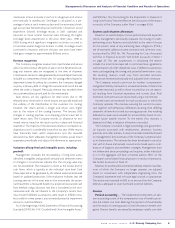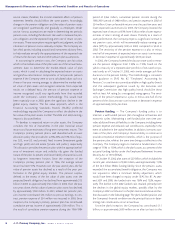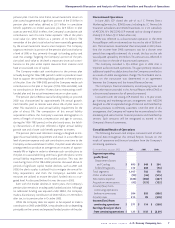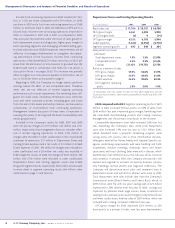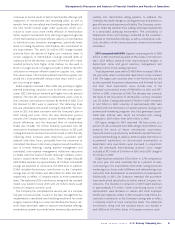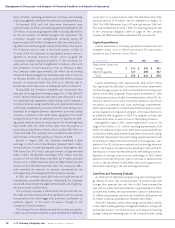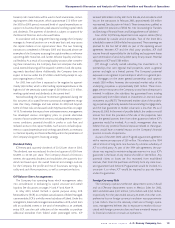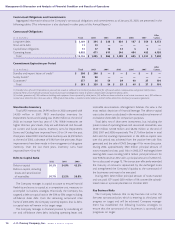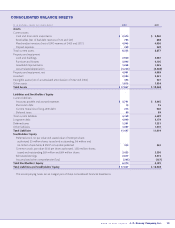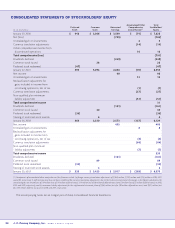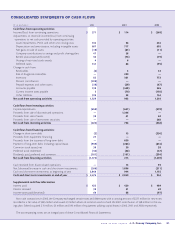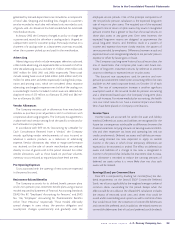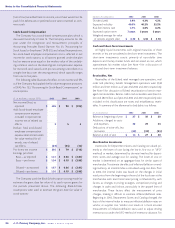JCPenney 2002 Annual Report Download - page 18
Download and view the complete annual report
Please find page 18 of the 2002 JCPenney annual report below. You can navigate through the pages in the report by either clicking on the pages listed below, or by using the keyword search tool below to find specific information within the annual report.
2002 annual report J. C. Penney Company, Inc. 15
Management’s Discussion and Analysis of Financial Condition and Results of Operations
• For Department Stores and Catalog the primary initiatives
have been to improve the merchandise assortments to more
fashionable items at value prices, support the offerings with
compelling marketing programs, improve the visual appeal of
the store environment and catalogs, reduce the expense
structure to more competitive levels, and concentrate on
placing the right people in the right jobs.
• At Eckerd, the focus has been on developing a strong man-
agement team, better product offerings, more competitive
pricing levels for general merchandise, reconfiguring drug-
stores to a more productive format and offering additional
convenient locations.
The Company believes that these initiatives will be the drivers
of its primary goal to strengthen and grow the customer franchise
after experiencing a period of deteriorating performance from
1995 to 2000. Management is focused on strengthening the
Company's value proposition with its customers.
While results have been positive for the most recent two years
and indicate that the Company is on track in achieving its finan-
cial targets, the turnaround is complex and the Company will face
continued challenges in the execution of its strategic initiatives.
An important factor in the Company’s turnaround is the ability
of department stores to operate under a centralized merchandis-
ing model. Under this model, professionals have been added to the
merchandising team with experience in buying centrally.
Additionally, certain information technology systems have been
developed, and others are in various stages of development, to
plan merchandise assortments, allocate inventory and stock stores,
better track sales trends to enable prompt replenishment and
manage pricing. To efficiently handle inventory flow the Company
is in the final stages of rolling out centralized logistics store support
centers. The effectiveness of these systems and processes as well as
their timely integration is an important component of the
Company’s ability to have the right inventory in the “right place, at
the right time, and at the right price.”
Another important factor in the Company’s turnaround is
the ability of Eckerd drugstores to continue to grow its drug-
store business and to maintain pharmacy margins, which are
under continued pressure, as managed care organizations and
other third party plans continue to seek cost containment. A
key component to growing the drugstore base is to have a
more competitive store-opening program and to complete the
remodeling and relocation program, which is designed to con-
vert existing stores to the reconfigured format that is more pro-
ductive and efficient.
The Company’s business is subject to other risk factors, both
internal and external, that may impact future operating and finan-
cial performance, such as the ability to anticipate fashion trends,
customer preferences and other fashion-related factors, attract or
retain customers in a highly competitive retail environment,
attract and retain key executives or other personnel, attract and
retain a sufficient number of qualified pharmacists, continue to
generate cash flow and obtain adequate financing. The Company
has in place an experienced management team that has estab-
lished programs and policies to manage and minimize those risks.
Accounting for Stock Options
The Company has a stock option program for approximately
2,000 executives and senior management. Over the past several
years, the Company’s annual net stock option grants (stock
options granted during the year, less any forfeitures or termina-
tions) under this program have averaged about 1.5% of outstand-
ing shares, including the common stock equivalent of preferred
shares. On January 25, 2003, options to purchase 22.3 million shares
of common stock, representing about 8% of total shares, were out-
standing, of which 14.6 million were exercisable. Of the exercisable
options, only 42% were “in-the-money” or had an exercise price
below the closing end-of-year stock price of $19.39. See Note 12 for
more details about the Company's stock option program.
The Company follows Accounting Principles Board Opinion No.
25, “Accounting for Stock Issued to Employees,” (APB 25) which
does not require expense recognition for stock options granted
when the exercise price of the option equals, or exceeds, the fair
market value of the common stock on the date of grant. See Note
1 on page 24 for further information about the Company’s stock
option accounting policy.
The Company evaluated its accounting for stock options during
2002, and elected to retain APB 25 accounting for several important
reasons. The Company believes that stock options are equity capi-
tal transactions, which increase the number of shares outstanding
when exercised, resulting in dilution of EPS and equity per share.
Since they increase the number of shares outstanding, the dilutive
effect of options is captured in the EPS calculation, and inclusion of
an expense for stock options in the statement of operations would
effectively result in a double charge to EPS. The cost of stock
options would be a non-cash expense that would not result in the
use of any operating resources and does not change the Company’s
equity balance. Additionally, before stock options are exercised, the
Company assumes they are exercised (to the extent they are dilu-
tive) for the diluted EPS calculation. Finally, the current stock-option
pricing models do not factor in significant limitations of employee
stock options such as vesting requirements, forfeiture provisions,
retention periods and nontransferability. Standard option-pricing
models were developed to value options traded in the marketplace,
and overstate the value of employee stock options.
The FASB is currently reviewing the accounting for stock
options, and may require the use of the fair value method pre-
scribed by SFAS No. 123, “Accounting for Stock-Based
Compensation.” In addition, the International Accounting
Standards Board has already issued a draft of accounting rules that
require the expensing of stock options, and the FASB is working
to align U.S. accounting with international standards. The
Company intends to continue its current accounting, which is no
expense recognition for stock options in the statement of opera-
tions, until the FASB clarifies stock option accounting for all U.S.
companies. See discussion of SFAS No. 148 under the new
accounting pronouncements section that follows.
New Accounting Pronouncements
FASB’s Emerging Issues Task Force (EITF) Issue No. 02-16,
“Accounting by a Reseller for Cash Consideration Received from a


